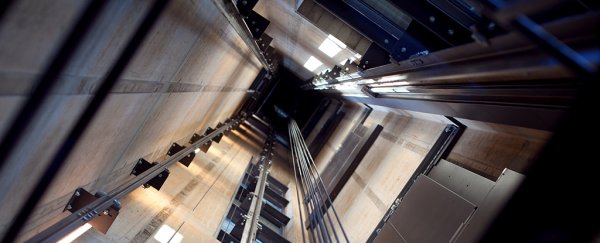Using the whole Solar System as a lab, and our most advanced time-keeping instruments for equipment, scientists have helped to verify the 'Einstein elevator' hypothesis – one of the central components of his general theory of relativity.
The theory deals with the basics of mass, gravity, space, and time – so proving as best as we can that it's correct is vital for the very foundations of physics as we know it.
What inspired Einstein's elevator idea – known officially as the equivalence principle – is that if you find yourself floating weightlessly in the middle of a sealed, windowless elevator, it's impossible to tell whether you're out in deep space, or accelerating very quickly towards the ground here on Earth.
You'll probably never find yourself in either scenario, but the underlying principle is that the same laws of physics apply no matter where you are, or how fast you are moving. Gravity is present in one situation and not the other, but there's the same result in both, and that's what Einstein realised.
There's a connected concept, the one measured in this study, which is that everything in that hypothetical, free-falling elevator would accelerate at the same pace – you, the coffee you've just let go of, a random stranger falling next to you, and so on.
To put this to the test, physicists from the National Institute of Standards and Technology (NIST) used Earth as the floating body and the Solar System as the elevator shaft.
For measuring acceleration, the researchers turned to the most advanced atomic clocks we currently have: four hydrogen masers and eight caesium fountain clocks. By comparing the ticks of these clocks across the course of 14 years, the team found a discrepancy of 0.00000022 plus or minus 0.00000025.
 (NIST)
(NIST)
This number is so incredibly close to zero, it's the best finding yet; because if Einstein was right, and all these clocks are falling through space at the same rate, that value should be zero.
In other words, despite the varying gravitational pulls of the Sun, Jupiter, and other objects, the atomic clock 'ticking' remains constant – just like our imaginary people and the other objects inside the elevator shaft remain constant relative to each other.
This is far from the first time the hypothesis has been verified, but scientists have never been able to measure it so accurately before, and that's thanks to the improvements being made in the accuracy of atomic clocks.
"The main reason we did this work was to highlight how atomic clocks are used to test fundamental physics," says one of the team, Bijunath Patla. "In particular, the foundations of general relativity."
There are still greater levels of accuracy to aim for, and more ways in which physicists can verify these results.
On top of that, more precise measurements for the equivalence principle mean more precise measurements for some of the other fundamentals of space and time in the Universe, and atomic clocks have an important role to play in that.
"We tie together tests of general relativity with atomic clocks, note the limitations of the current generation of clocks, and present a future outlook for how next-generation clocks will become very relevant," says Patla.
There are still inconsistencies to explain between general relativity and quantum mechanics, but that's for future studies to look at. For now, Einstein wins again.
The research has been published in Nature Physics.
